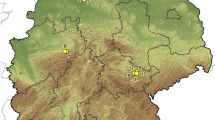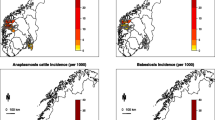Abstract
The tick Ixodes ricinus (L.) is a known vector of several zoonotic diseases such as Tick Borne Encephalitis (TBE), Lyme borreliosis and ehrlichiosis. The interaction between humans and ticks are at the very core of our understanding of the epidemiology of tick borne zoonoses, but only few experimental studies have been performed. Hence our understanding of the epidemiology of tick-borne disease has to rest on the assumption that the potential tick activity, which is reflected in tick samples from the vegetation or samples from animals, corresponds with tick–human interaction. Observations which may reflect the long term tick–human contact are available in Denmark. These observations are records of requests for information on I. ricinus forwarded to the Danish Pest Infestation Laboratory (DPIL). This article was based on the assumption that the request could be seen as a measure of tick–human interaction reflecting the tick densities in relative terms. The perceived tick densities given by the number of requests on I. ricinus divided by the total number of requests to DPIL was fairly stable from 1965 to 1985, while it doubled during the late 1980’s reaching a higher level in the beginning of the 1990’s. The perceived density was well explained by the variation in temperature, solar radiation (monthly measurement) and deer abundance (yearly assessments). The measure of deviation, i.e. the ratio between observed requests +1 and modelled requests +1, for the individual years varied between 0.91 and 1.20, with considerable within-year variation. A gradual change in periodicity of the residual might suggest gradually changing tick population dynamics. In conclusion, the perceived tick densities appear to be consistent with the current knowledge of tick ecology and tick-transmitted diseases.
Similar content being viewed by others
References
A.N. Alekseev H.V. Dubinina (2000) ArticleTitleAbiotic and diel and seasonal activity of Borrelia infected and uninfected Ixodes persulcatus (Acarina: Ixodidae). J. Med Entomol. 37 9–15 Occurrence Handle1:STN:280:DC%2BD2czhslajsQ%3D%3D
D.R. Arthur (1962) Tick and tick disease. International Series of Monographs on Pure and Applied Biology, Vol. 9 Pergamon Press Oxford
R.J. Bauch (1972) ArticleTitleBionomy of Ixodes ricinus. II population and seasonal dynamics inseveral localities of the district of Magdeburg in GDR Angew. Parasitol. 13 IssueID3 141–154 Occurrence Handle1:STN:280:DyaE3s3ks12iuw%3D%3D Occurrence Handle4666506
V.N. Belozerov (1968) Photoperiodic control of seasonal development in ixodid ticks Translation 432 (T432) Dept. Medical Zoology, United States Naval Medical Research Unit. No.3 CairoEgypt
W. Burgdorfer (1986) ArticleTitleDiscovery of the Lyme spirochete: a historical review Zentralblatt für bakteriologieMicrobiologie und hygiene A 263 7 Occurrence Handle1:STN:280:DyaL2s3gvVGlsg%3D%3D
R.P. Cody J.K. Smith (1997) Applied Statistics and the SAS Programming Language4th ed Prentice-Hall inc., Simon and Schuster New Jersey, USA
T.J. Daniels D. Fish I. Schwarts (1993) ArticleTitleReduced Abundance of Ixodes scapularis (Acari: Ixodidae) and Lyme Disease risk by deer exclusion J. Med. Entomol. 30 IssueID6 1043–1049 Occurrence Handle1:STN:280:DyaK2c%2Fps1emuw%3D%3D Occurrence Handle8271246
A. Estrada-Peña F. Jongejan (1999) ArticleTitleTicks feeding on humans: a review of records on human biting Ixodoidea with special reference to pathogen transmission. Exp Appl. Acarol. 23 685–715 Occurrence Handle10.1023/A:1006241108739
J.S. Gray (1991) ArticleTitleThe development and seasonal activity of the tick Ixodes ricinus: a vector of Lyme borreliosis Rev. Med. Vet. Entomol. 79 IssueID6 232–333
J.S. Gray (1985) ArticleTitleStudies on the larval activity of the tick Ixodes ricinus L. in co Wicklow, Ireland Exp. Appl. Acarol. 1 307–316 Occurrence Handle10.1007/BF01201570 Occurrence Handle1:STN:280:DyaL1c3kt1entg%3D%3D Occurrence Handle3870961
Hansen K. and Lebech A. 1992. The clinical and epidemiological profile of Lyme neuroborreliosis in Denmark.
P.F. Humair N. Turrian A. Aeschlimann L. Gern (1993) ArticleTitle Ixodes ricinus immatures in a focus of Lyme disease Folia Parasitologica. 40 IssueID3 237–242 Occurrence Handle1:STN:280:DyaK2c7kvVehsQ%3D%3D Occurrence Handle8314179
P.F. Humair D. Postic R. Wallich L. Gern (1998) ArticleTitleAn Avian reservoir (Turdus merula) of the Lyme disease spirochetes Zentrallblatt für Bakteriologie 287 521–538 Occurrence Handle1:STN:280:DyaK1czgt1OgtQ%3D%3D
P.F. Humair O. Rais L. Gern (1999) ArticleTitleTransmission of Borrelia afzelii from Apodemus mice and Clethinomys voles to Ixodes ricinus ticks: differential transmission patterns and over wintering maintenance Parasitology 118 33–42 Occurrence Handle10.1017/S0031182098003564 Occurrence Handle10070659
F.S. Jensen N.E. Koch (1997) Friluftsliv i skovene 1976/77 –1993/1994. Forskningsserien nr 20 Forskningscenteret for Skov og Landskab HørsholmDenmark
P.M. Jensen (2000a) Seasonal and geographical abundance of I. ricinus and Lyme Borreliosis risk assessment in Denmark Dissertation for the degree of Doctor of Philosophy at the Royal Veterinary and Agricultural University Denmark
P.M. Jensen (2000b) ArticleTitleSeasonal activity of Ixodes ricinus ticks based on consecutive flagging Exp. App. Acarol. 24 IssueID9 695–708 Occurrence Handle10.1023/A:1010640219816 Occurrence Handle1:STN:280:DC%2BD3M3ksVyitQ%3D%3D
P.M. Jensen H. Hansen F. Frandsen (2000) ArticleTitleSpatial Risk Assessment in Denmark of Lyme Borreliosis in Denmark Scand. J. Infect. Dis. 32 545–550 Occurrence Handle10.1080/003655400458857 Occurrence Handle1:STN:280:DC%2BD3crgsV2rsw%3D%3D Occurrence Handle11055662
P.M. Jensen U. Kaufmann (2003) ArticleTitleSeasonal and diel activity of Ixodes ricinus (Acari: Ixodidae) subpopulations in Denmark. Aspects of sizephysiological agean malate dehydrogenase genotype in a forest site without undergrowth. Exp. Appl. Acarol. 30 289–303 Occurrence Handle10.1023/B:APPA.0000006515.66461.32 Occurrence Handle1:STN:280:DC%2BD2c%2FlsFWgsQ%3D%3D Occurrence Handle14756394
V. Kalsbeek F. Frandsen (1996) ArticleTitleThe seasonal activity of Ixodes ricinus in Denmark Anzeiger für SchädlingskundePflanzenschutz und Umweltschutz 69 160–161
N.E. Koch (1984) Forest recreation in Denmark (Skovenes friluftsfunktion i Danmark), Særtryk af Det Forstlige Forsøgsvæsen i Danmark Beretning nr. 330 Statens Forstlige Forsøgsvæsen Klampenborg, Danmark
K. Kurtenbach H. Kampen A. Dizij S. Arndt H.M. Seitz U. E. Schaible M.M. Simon (1995) ArticleTitleInfestation of rodents with larval Ixodes ricinus (Acari: Ixodidae) is an important factor in the transmission cycle of Borrelia burgdorferi s.l. in German woodlands J. Med. Entomol. 32 IssueID6 807–817 Occurrence Handle1:STN:280:DyaK287gt1CktA%3D%3D Occurrence Handle8551503
A.S. Landbo P.T. Flöng (1992) ArticleTitle Borrelia burgdorferi in Ixodes ricinus from habitats in Denmark Med. Vet. Entomol. 6 165–167 Occurrence Handle1:STN:280:DyaK3s%2FktlClsA%3D%3D Occurrence Handle1421487
M. L’Hostic H. Dumon A. Fusade S. Lazareff A. Gorenflot (1996) ArticleTitleSeasonal incidence of Ixodes ricinus ticks (Acari: Ixodidae) on rodents in France Exp. Appl. Acarol. 20 359–368 Occurrence Handle10.1007/BF00130548 Occurrence Handle8771769
W.D. McEnroe (1979) Dermacentor variabilis (Say) in Eastern Massachusetts J.D. Rodriguez (Eds) Recent Advances in Acarology Vol. II Academic Press New York 145–153
J. Mcleod (1936) ArticleTitle Ixodes ricinus in relation to its physical environmentIV An analysis of the ecological complexes controlling distribution and activities Parasitology 28 IssueID3 295–319 Occurrence Handle10.1017/S0031182000022502
C.B. Nyle R.R. Weil (1996) The Nature and Properties of soils 11th ed Prentice-Hall Inc. New Jersey, USA
Olesen C.R. Asfreg og MC Forchhammer 2002. Rådyret - fra fåtallig til almindelig. Tema rapport nr. 39. DMU. 60 sider.
J.L. Perret E. Guigoz O. Rais L. Gern (2000) ArticleTitleInfluence of saturation deficit and temperature on Ixodes ricinus tick questing activity in a Lyme borreliosis-endemic area (Switzerland) Parasitol. Res. 86 IssueID7 554–557 Occurrence Handle10.1007/s004360000209 Occurrence Handle1:STN:280:DC%2BD3M%2FlslaksA%3D%3D Occurrence Handle10935905
S.E. Randolph L. Gern P.A. Nuttall (1996) ArticleTitleCo-feeding ticks: epidemiological significance for ticks borne pathogen transmission Parasitol. Today 12 IssueID12 472–478 Occurrence Handle10.1016/S0169-4758(96)10072-7 Occurrence Handle1:STN:280:DC%2BD2cznsVyqsQ%3D%3D Occurrence Handle15275266
S.E. Randolph D. Miklisová J. Lysy D.J. Rogers M. Labuda (1999) ArticleTitleIncidence from coincidence: patterns of tick infestations on rodents facilitate transmission of tick-borne encephalitis virus Parasitology 118 177–186 Occurrence Handle10.1017/S0031182098003643 Occurrence Handle10028532
S.E. Randolph R.M. Green M.F. Peacey D.J. Rogers (2000) ArticleTitleSeasonal synchrony: the key to tick borne encephalitis foci identified by satellite data Parasitology 121 15–23 Occurrence Handle10.1017/S0031182099006083 Occurrence Handle11085221
S.E. Randolph (2001) ArticleTitleThe shifting landscape of tick-borne zoonoses: tick-borne encephalitis and Lyme borreliosis in Europe Phil. Trans. R. Lond. B. 356 1045–1056 Occurrence Handle10.1098/rstb.2001.0893 Occurrence Handle1:STN:280:DC%2BD3MvntVChtA%3D%3D
S.E. Randolph R.M. Green A.N. Hoodless M.F. Peacey (2002) ArticleTitleAn empirical quantitative framework for the populations dynamics of the tick Ixodes ricinus Int. J. Parasitol. 32 979–989 Occurrence Handle10.1016/S0020-7519(02)00030-9 Occurrence Handle12076627
D.E. Sonenshine (1991) Biology of ticks, Vol. 1 and 2. Oxford University Press New York
T. Smith F.L. Kilbourne (1893) Investigations into the naturecausation and prevention of Texas or Southern cattle fever Bulletin of the Bureau of Animal Ind., US. Department of Agriculture
G. Stanek S. O’Connel M. Cimmino E. Aberer W. Kristoferitsch M. Granström E. Guy J. Gray (1996) ArticleTitleEuropean Union Concerted Action on Lyme borreliosis: clinical case definitions for Lyme borreliosis Wien Klin Wochenschr 108 IssueID23 741–747 Occurrence Handle1:STN:280:DyaK2s7ksVOmtQ%3D%3D Occurrence Handle8990511
L. Stjernberg J. Berglund (2002) ArticleTitleRisk of acquiring tick bites in south-Eastern Sweden Scand. J. infect. Dis. 34 840–844 Occurrence Handle10.1080/0036554021000026955 Occurrence Handle12578156
L. Stjernberg J. Berglund (2000) ArticleTitleGarlic as insect repellent JAMA 16 IssueID7 831 Occurrence Handle10.1001/jama.284.7.831
Sundhedsstyrelsen, 1996. Klassifikation af sygdommesystematisk del 2. udg. MunksgaardDanmark. Translation of: International statistical classification of diseases and health related problems (WHO, 1992).
A. Tälleklint (1996) Transmission of Lyme borreliosis spirochetes at the tick vector mammal reservoir interface. Comprehensive Summaries of Uppsala Disertations from the Faculty of Science and Technology 200 Acta Universitatis Upsaliensis Uppsala
R.P. Van Es G. Gettingby E. Hillerton (1999) ArticleTitleModels of temporal variation in questing activity in individuals of Ixodes ricinus (Acari: Ixodidae) Exp. Appl. Acarol. 23 977–986 Occurrence Handle10.1023/A:1006331331642 Occurrence Handle1:STN:280:DC%2BD3c7pvF2qsQ%3D%3D Occurrence Handle10737732
R. Wurm G. Dobler S.T. Kiessig (1999) ArticleTitleSerological investigation of red foxes (Vulpes vulpes L.) for determining the spread of tick borne encephalitis in Nirthrine-Westphalia J. Vet. Med. B 47 IssueID7 503–509 Occurrence Handle10.1046/j.1439-0450.2000.00373.x
P. Webster F. Frandsen (1994) ArticleTitlePrevalence of antibodies to Borrelia burgdorferi in Danish deer APMIS 102 287–290 Occurrence Handle1:STN:280:DyaK2c3otVyisQ%3D%3D Occurrence Handle8011306 Occurrence Handle10.1111/j.1699-0463.1994.tb04877.x
P. Zeman J. Januska (1999) ArticleTitleEpizootiologic background of dissimilar distribution of human cases of Lyme borreliosis and Tick-borne encephalitis in a joint endemic areas Comp. Immunol. Microbiol. Infect. Dis. 22 247–260 Occurrence Handle10.1016/S0147-9571(99)00015-6 Occurrence Handle1:STN:280:DyaK1Mzpt12qtQ%3D%3D Occurrence Handle10465328
Author information
Authors and Affiliations
Corresponding author
Rights and permissions
About this article
Cite this article
Jensen, P.M., Jespersen, J.B. Five decades of tick–man interaction in Denmark – an analysis. Exp Appl Acarol 35, 131–146 (2005). https://doi.org/10.1007/s10493-004-1991-7
Received:
Accepted:
Issue Date:
DOI: https://doi.org/10.1007/s10493-004-1991-7




